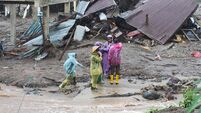Possibly more gas near Corrib

British explorer Europa Oil and Gas has hinted at the potential for significant new discoveries near the Corrib gas field off Ireland’s north-west coast, writes .
The company, which has an estimated near five billion barrels of oil across seven licences offshore Ireland, has estimated 2.5 trillion cubic feet of gas at its Slyne Basin exploration area, which lies adjacent to Corrib.
Shares in the company — which is actively seeking farm-out deals for its Irish assets — rose by nearly 7% on its latest news.
Meanwhile, Irish exploration company Falcon Oil and Gas has been buoyed by an independent study suggesting a moratorium on fracking methods in onshore drilling in Australia may be lifted early next year.

Falcon owns a 30% stake in the much-hyped Beetaloo Basin shale gas field in Australia’s Northern Territory, where there has been a halt on fracking, or hydraulic fracturing, for the past 14 months.
A final decision on the future of the moratorium will be made by local government in March. However, an independent draft final report commissioned by the government this week hints at a lifting of the temporary ban by saying the risks associated with fracking are manageable.
“It is the panel’s opinion that, provided that the recommendations made in this report are adopted and implemented, not only should the risk of any harm be minimised to an acceptable level, in some instances, it can be avoided altogether,” the draft report said.
Those recommendations include implementing new technologies and adhering to world-leading engineering standards.
A lifting of the moratorium would allow Falcon and its senior partner at Beetaloo, Origin Energy, to resume drilling and complete a further five-well programme at the massive field.
Philip O’Quigley, Falcon’s chief executive, said the move was “an amber light” towards resuming work at Beetaloo. Falcon’s share price initially jumped 10% on yesterday’s news, but was down 3% yesterday.
Fracking relates to the extraction of gas whereby water, sand and chemicals are pumped into gas-bearing rock at high pressures.
The technique has drawn much criticism, with concerns persisting over potentially negative knock-on effects on water and air quality in surrounding areas.















